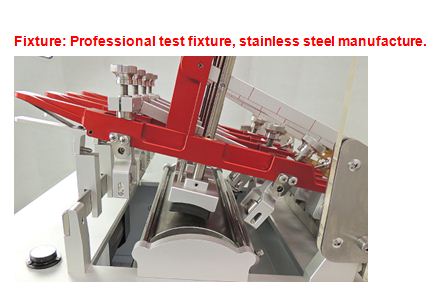Description
Summary:
Oscillatory Wyzenbeek Abrasion Tester to determine the abrasion resistance of fabric. It complies with
ASTM D4157. Modern ergonomic design to determine the abrasion resistance of fabrics when rubbed against a standard abradant or a wire mesh screen with a backward and forward motion over a curved
surface. Wyzenbeek abrasion tester applies to automotive and furniture industry fabric manufacturers working to US Standards Motor driven with 4 abrasion heads and electronic digital counter to control the number of cycles.
Test Method:
ASTM D4157: Standard Test Method for Abrasion Resistance of Textile Fabrics (Oscillatory Cylinder Method)
Double rubs are a measure of how resistant fabric is to abrasive forces. The vast majority of fabrics list them, and they help to determine what fabric is most suitable for the specific purpose you require. Double rubs are determined by an automated test known as the Wyzenbeek Test (also referred to as the Wyzenbeek Method).
According to wikipedia, in the US, the Wyzenbeek test is often used instead of the Martindale.
Following the Association for Contract Textiles Guidelines for General Contract Upholstery using a Wyzenbeek Abrasion Tester- Oscillatory Cylinder Method
Covers the determination of the abrasion resistance of woven textile fabrics using the Oscillatory Cylinder Tester. May not be usable for some fabric constructions.
- Sample is conditioned and run in atmospheric conditions for textiles
- #10 Cotton Duck abradant; using a tension of 4lbs and a compression force of 3lbs
- At least 2 specimens in the warp and 2 specimens in the filling direction are tested
- The number of double rub cycles achieved before two yarn breaks occur or “noticeable wear” is observed is recorded as the fabric’s abrasion rating
Features of our Wyzenbeek Abrasion Test Machine:
- Robust mechanical components are constructed of Aluminum and Stainless Steel
- Durable Powder Coat and Anodized finishes
- High Quality THK Precision Bearings.
- Programmable count-up controller with automatic stop
- Adjustable jog and test speed controls
- Supply voltages vary and must be specified at time of purchase
- High quality brushless electric motor
Specifications:
| Testing stations | 4 groups |
| Testing speed | 90±1 r/min |
| Abrasion platform arc | Arc: 76 mm Length:300mm |
| Abrasion stroke | 76±2mm |
| Abrasion head | Bottom pressure head 50*50mm, Arc R80mm |
| Tension on sample | 4 lbf (17.8N), adjustable |
| Load on sample | 3 lbf (13.4N), adjustable |
| Dimension of sample | 73*245mm |
| Vacuum cleaner | ≤4cfm |
| Power | 220V 50Hz |
Standard accessories
- 1 pack of rubber pad
- 1 pack of Wyzenbeek metal net
- 1 standard grinding material, #10 cotton canvas
- 1 fine sandpaper
- 1 nylon brus
NEWGOER is a professional manufacturer for various test equipment, we denote ourselves to making best quality products and service for providing you a suitable solutions!
We focus on every details of product quality and precision.


In North America, The Wyzenbeek Method is the standard measure of a fabric’s abrasive resistance. A piece of stiff cotton cloth is laid over a machine and rubbed all over a sample of the fabric. The rubbing from sitting on a seat cushion is what the test attempts to replicate. Each backward and forward motion makes up one rub. The test continues until the fabric shows visible wear, two yarn breaks or 15,000 double rubs, which is regarded as too intense for domestic purposes.
Europe and Asia majorly recognize the Martindale Method for fabric abrasion test. This method is generally regarded as more accurate than the Wyzenbeek. A sample of the fabric is laid out flat and stroked in an adapted figure-eight movement against a piece of smooth woolen cloth. What is counted is the number of cycles the fabric endures prior to displaying some sign of wear.
The American Society of Testing and Materials (ASTM) acknowledges and accepts these two abrasion test methods.













Reviews
There are no reviews yet.